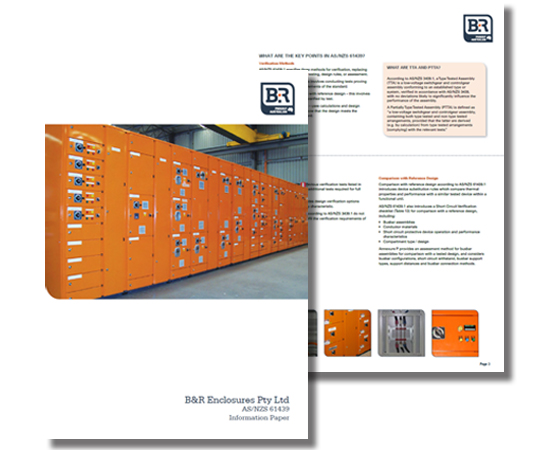
AS/NZS 61439 Information and Enclosures from B&R
Information and compliant, certified enclosures for the AS/NZS 61439 standard in effect in 2021.
What is AS/NZS 61439?
AS/NZS 61439 is the new series of standards for low-voltage (LV) switchgear and control gear assemblies. The standard series is an adoption of the IEC 61439 series, with variations to include Australian and New Zealand conditions. The standard was introduced in 2016 and superseded AS/NZS 3439 on 24 May 2021. AS/NZS 61439 is further referred to in the Australian Wiring Rules AS/NZS 3000:2018 amendment 2.
Why was the standard changed to AS/NZS 61439?
The main objective of the new AS/NZS 61439 standard is to harmonise rules and requirements applicable to low-voltage switchgear and control gear assemblies, while achieving uniformity of requirements and verification for assemblies and removing the need for verification to other standards.
This series of standards fundamentally improves robustness and ensures higher levels of specification, driving improved safety and performance. These improvements minimise customer dissatisfaction from under specified switchboards causing faults that could bring loss of income or worst case, life.
Does every switchboard have to comply with AS/NZS 61439?
No. If the board is rated for equal to or less than 125Amps AND it is short circuit fault rated equal to or less than 10kA then compliance to the AS/NZS 61439 standard is not needed. This is the only exemption, all other switchboards must be compliant to the AS/NZS 61439 standard.
The exemption above is legislated at 125Amp and 10kA, however B&R are aware that individual electrical authorities may make different demands within the area of responsibility. It is incumbent upon the contractor to be aware of regional variations.
NOTE: For boards that do not need to comply to AS/NZS 61439, then they must still comply with AS/NZS 3000.
How do you get a product to comply with AS/NZS 61439?
The standard requires all final assemblies to meet or exceed this standard's constructional and performance requirements. To assist, 13 design and performance characteristics are identified in Annex D, design verification Table D1 of the standard. The Table can be found further down this page.
What are the Verification Methods?
Below are the three methods of verification which can be used to verify the characteristics in Table D1. The Table also dictates which verification methods can or can't be used to verify each of the 13 constructional and performance characteristics.
VERIFICATION BY TEST (previously known as Type Test)
A test is performed on a sample of an assembly or on parts of assemblies to check the design satisfies the requirements.
NOTE: Where tests have been conducted in accordance with IEC 60439, IEC 61439 or the AS/NZS 3439 series, and the test results fulfil the requirements of the relevant part of the AS/NZS 61439 series, further verification of these requirements need not be repeated.
VERIFICATION BY COMPARISON
The switchboard or relevant section of the switchboard is compared to a test verified reference design. A test verified reference design is when a switchboard that has already been tested becomes a reference design. Then, when a new board has the same elements of the tested reference design, the new switchboard is compliant by comparison.
VERIFICATION BY ASSESSMENT
This includes the strict verification by correct application of design rules and calculations, including use of appropriate safety margins.
61439 Annex D, Table D1
This table shows the 13 constructional and performance characteristics which the AS/NZS 61439 standard requires all final switchboard assemblies to meet or exceed, for compliance.
Please click the button below for compliance information on the B&R range of products.
What about ARC fault containment?
Arc fault containment is not a requirement for compliance to AS/NZS 61439. Under AS/NZS 61439 arc fault containment is an informative appendix ZC. Importantly this standard does NOT define requirements for arc flash protection (calculations for PPE).
If arc fault testing is performed then appendix ZD shall be followed. Arc fault testing is done to assess the ability of a switchboard to limit risk, it should however be realised that it is not possible to simulate all conditions and that an arc does not always behave in a repeatable manner.

